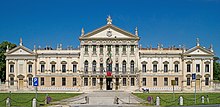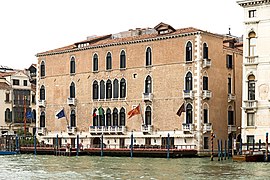
Vincenzo Scamozzi was an Italian architect and a writer on architecture, active mainly in Vicenza and Republic of Venice area in the second half of the 16th century. He was perhaps the most important figure there between Andrea Palladio, whose unfinished projects he inherited at Palladio's death in 1580, and Baldassarre Longhena, Scamozzi's only pupil.
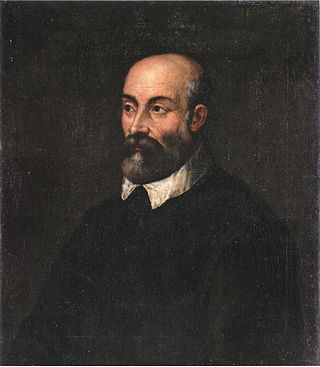
Andrea Palladio was an Italian Renaissance architect active in the Venetian Republic. Palladio, influenced by Roman and Greek architecture, primarily Vitruvius, is widely considered to be one of the most influential individuals in the history of architecture. While he designed churches and palaces, he was best known for country houses and villas. His teachings, summarized in the architectural treatise, The Four Books of Architecture, gained him wide recognition.

The Grand Canal is the largest channel in Venice, Italy, forming one of the major water-traffic corridors in the city.
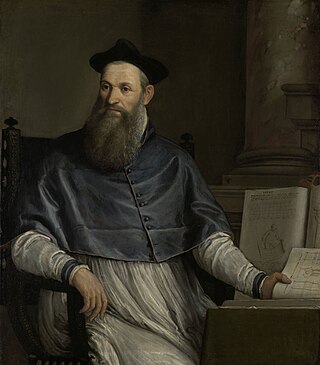
Daniele Matteo Alvise Barbaro was an Italian cleric and diplomat. He was also an architect, writer on architecture, and translator of, and commentator on, Vitruvius.

The Barbaro family was a patrician family of Venice. They were wealthy and influential and owned large estates in the Veneto above Treviso. Various members were noted as church leaders, diplomats, patrons of the arts, military commanders, philosophers, scholars, and scientists.

Villa Pisani at Stra refers to the monumental, late-Baroque rural palace located along the Brenta Canal at Via Doge Pisani 7 near the town of Stra, on the mainland of the Veneto, northern Italy. This villa is one of the largest examples of Villa Veneta located in the Riviera del Brenta, the canal linking Venice to Padua. The patrician Pisani family of Venice commissioned a number of villas, also known as Villa Pisani across the Venetian mainland. The villa and gardens now operate as a national museum, and the site sponsors art exhibitions.

Il Ballo del Doge is a Venetian masquerade ball, one of the many events held annually during the Carnival of Venice. The ball itself is held in the 15th-century Venetian palace of Palazzo Pisani Moretta, situated on the Grand Canal in Venice. The ball's name derives from the title of the elected heads who ruled Venice up until the fall of the Venetian republic in the 18th century. Every year the ball is attended by around four hundred guests dressed in period costume and masked.

The Palazzo Tiepolo is a Renaissance-style palace located between the Palazzo Soranzo Pisani and the Palazzo Pisani Moretta on the Grand Canal, in the Sestieri of San Polo, Venice, Italy.
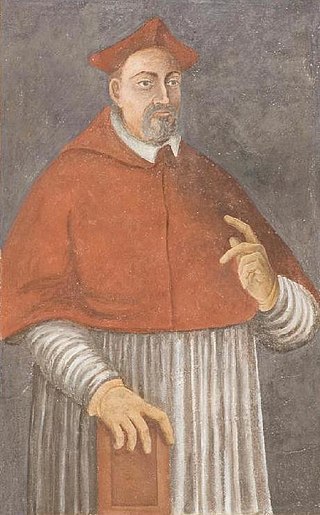
Francesco Pisani was an Italian Cardinal, born in Venice, the son of Alvise Pisani the noted banker, who was Procurator of S. Mark's, a member of the Council of Ten, and a Councilor of the Doge of Venice; and Cecilia Giustinian. He had a brother named Giovanni (Zuan), who also became Procurator of S. Marks' and was a Venetian diplomat; he was married to the sister of Doge Andrea Gritti. He was a strong supporter of the alliance between Venice, France and the Papacy, called the League of Cognac. He shared the imprisonment of Pope Clement VII in the Castel S. Angelo during the Sack of Rome and its aftermath. He spent eighteen months in exile in Naples while Clement made his peace with the Emperor Charles V.

The Villa Pisani is a patrician villa designed by Italian Renaissance architect Andrea Palladio, located in Bagnolo, a hamlet in the comune of Lonigo in the Veneto region of Italy.

The House of Loredan is a Venetian noble family of supposed ancient Roman origin, which has played a significant role in shaping the history of the Mediterranean world. A political dynasty, the family has throughout the centuries produced a number of famous personalities: doges, statesmen, magnates, financiers, diplomats, procurators, military commanders, naval captains, church dignitaries, and writers.
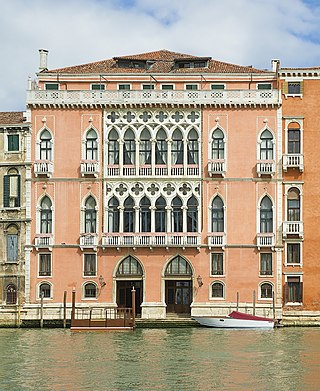
Palazzo Pisani Moretta is a palace situated along the Grand Canal in Venice, Italy, between Palazzo Tiepolo and Palazzo Barbarigo della Terrazza.
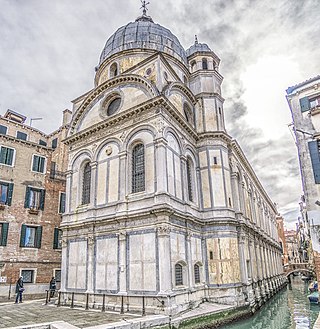
Venetian Renaissance architecture began rather later than in Florence, not really before the 1480s, and throughout the period mostly relied on architects imported from elsewhere in Italy. The city was very rich during the period, and prone to fires, so there was a large amount of building going on most of the time, and at least the facades of Venetian buildings were often particularly luxuriantly ornamented.

The Palazzo Pisani Gritti is a Venetian Gothic palazzo located on the north side of the Grand Canal, opposite the Church of the Salute, between the Campo del Traghetto and the Rio de l'Alboro, in the Sestieri of San Marco, Venice, Italy. It was the residence of Doge Andrea Gritti in the 16th century. It is now the Gritti Palace Hotel.

The Palazzo Pisani a Santo Stefano is a large palace located facing Campo Santo Stefano, in an alley near the facade of the church of San Vidal, in the sestiere of San Marco, in the city of Venice, Italy. The palace is owned by the city and now houses the Conservatorio di Musica Benedetto Marcello di Venezia, founded in 1876.
Palazzo Pisani may refer to one of the follow Venetian palazzos:

The Valmarana family is an aristocratic family in Vicenza, one branch of which also held Venetian patrician status. Its motto was "Plus Ultra" (Further). They were named after the village of Valmarana in the Berici Hills, where they held fiefs from the bishop of Vicenza.

Palazzetto Tiepolo or Palazzo Soranzo Pisani is a 15th century palace in Venice, located in the San Polo district and overlooking the right side of the Grand Canal, between Palazzo Tiepolo and Palazzo Tiepolo Passi. The name Palazzo Soranzo Pisani reflects the noble families Soranzo and Pisani. Thus, including the present owner the Passi Family and the Tiopolo family, the palace has been in the possession of four noble venetian families.
This is an alphabetical index of people, places, things, and concepts related to or originating from the Republic of Venice. Feel free to add more, and create missing pages.

